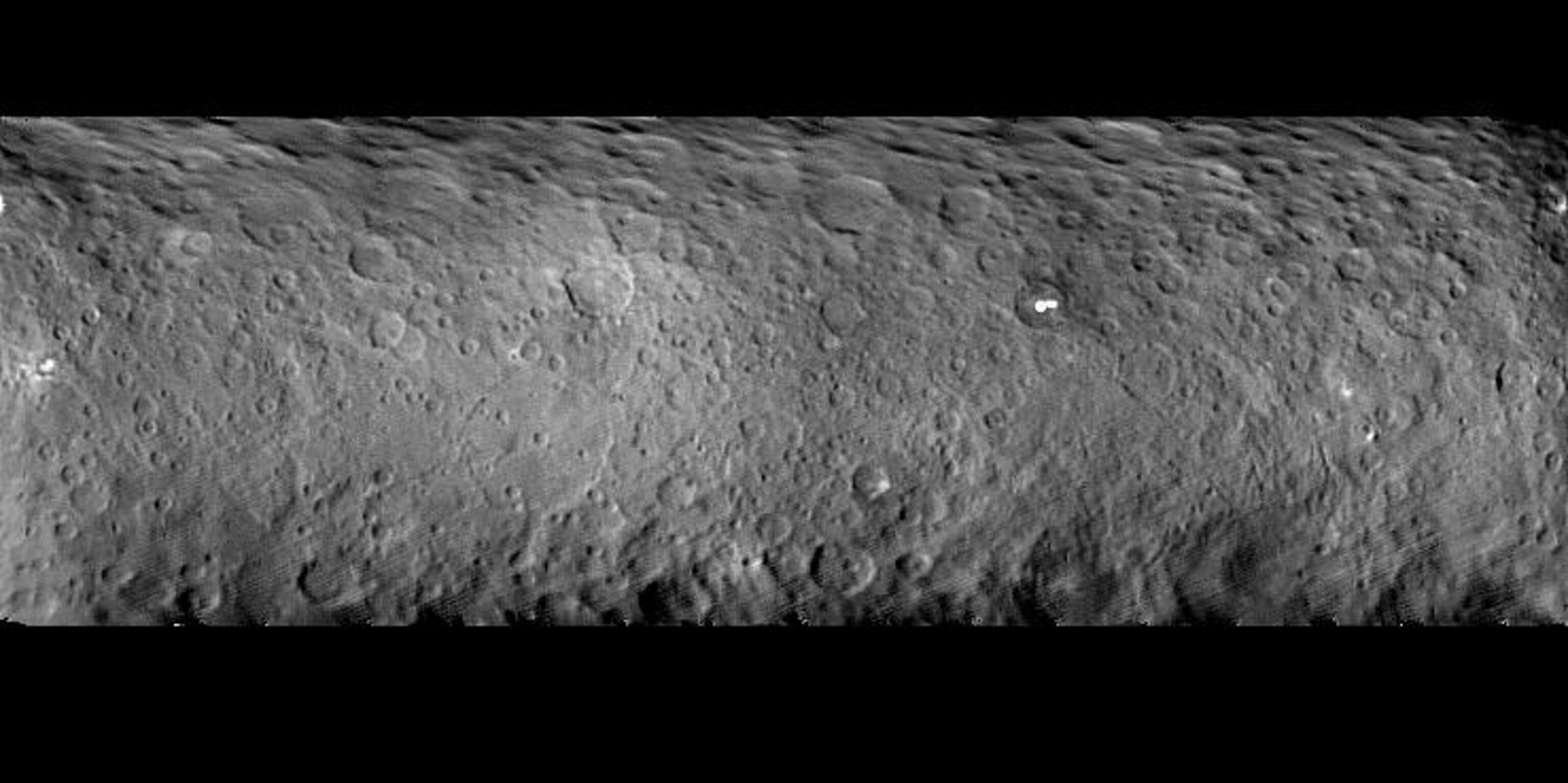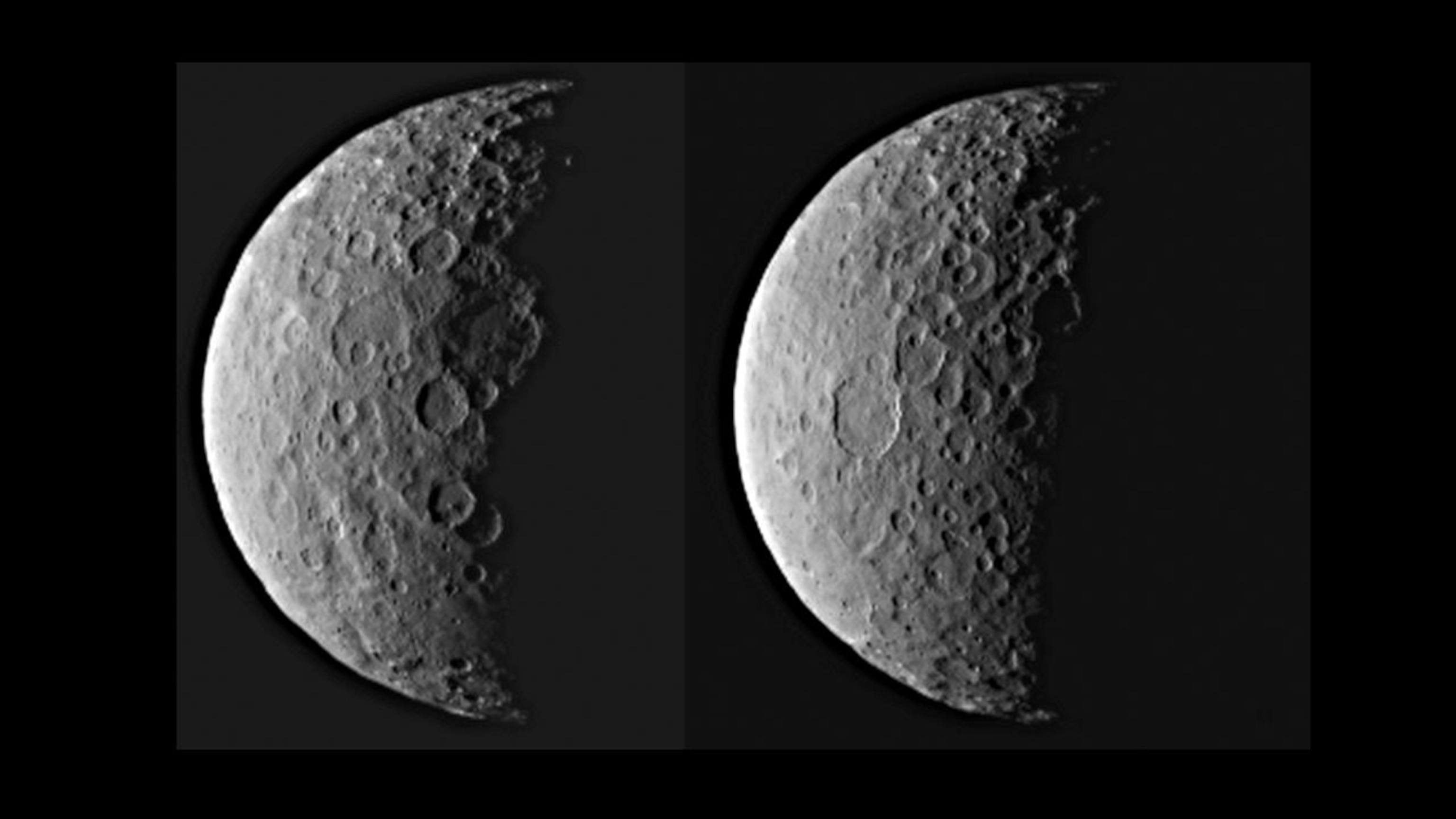
For Dwarf Planet Ceres, 4.6 Billion Years of Anonymity End This Week
Update March 6, 6:50 a.m. PST: Dawn has successfully pulled into orbit around Ceres. The spacecraft’s arrival marks a series of firsts: It’s the first to orbit a dwarf planet, and the first to orbit two extraterrestrial worlds. Now, let the science begin!
Later this week, a small and utterly mysterious world will receive its first interplanetary visitor.
Early Friday morning, NASA’s Dawn spacecraft is scheduled to slip into orbit around Ceres, the largest body in the asteroid belt. Covered in strange, unexplained bright spots, Ceres is not just a normal, potato-shaped asteroid.
In fact, it’s not an asteroid at all – it’s a dwarf planet, just like Pluto. And it will be the first dwarf planet ever explored by an orbiting spacecraft.
“Every time we visit a new object, be it a planet or a satellite, we are always surprised,” said Charles Elachi, director of the Jet Propulsion Laboratory, during a news conference about the mission.
Dawn will spend at least 15 months exploring the inner solar system’s only dwarf planet.
Strange New World
For now, scientists are poring over each increasingly detailed image of the world and trying to decipher the oddities they contain. Chief among the mysteries are Ceres’ bright spots – the white specks that leap out of every set of images Dawn has snapped since it entered Ceres’ neighborhood. The newest set of images reveals that one enormous white spot, a splotch so big it’s even visible in grainy Hubble images, is actually two spots. And they’re parked in a 92-kilometer-wide crater.
“This extreme brightness was really unexpected,” says JPL’s Carol Raymond, deputy principal investigator on the Dawn mission. “It is unique in the solar system and we will be revealing its true nature as we get closer and closer to the surface.”
Scientists suspect the spots are highly reflective water ice, but they don’t know for sure, and they definitely don’t know how the spots ended up on Ceres’ surface. It’s possible they’ve been excavated by impacts, Raymond says. But she notes they could have something to do with tufts of water vapor reported rising from Ceres in January 2014.
“This crater is located in one of those [areas], so it might be related to that water vapor emission,” Raymond says.
A more tantalizing – but less likely – possibility is that the spots are associated with icy volcanoes. Such cryovolcanism might suggest that liquid water still lives beneath Ceres’ crust, but Raymond points out there aren’t any of the surface features expected to form around ice volcanoes.
Another mystery waiting to be solved has to do with a puzzlingly flat (and huge) crater in Ceres’ southern hemisphere. The bottoms of impact basins are normally curved, but this one is not. Whether it’s been filled in with some kind of substance, or is simply deformed because of a buried layer of soft water ice, is unclear.
What is clear is that with patience, these – and other mysteries – will be solved at Ceres.

The Potential For Life?
Round and warm, 4.6 billion-year-old Ceres has a cratered surface that scientists think might conceal a layer of water ice. Once upon a time, though, when the world was younger, that layer of ice may have been a buried, watery ocean. In that way, Ceres could be similar to some icy outer solar system moons like Europa and Enceladus, both of which have subsurface oceans hiding beneath their icy crusts.
Those similarities beg the question of whether Ceres may have been – or could still be – capable of supporting life as we know it. After all, searching for the signatures of life on Europa and Enceladus is squarely atop most astrobiological to-do lists.
“We do expect that [Ceres] had astrobiological potential,” Raymond says.
Slipping Back to the Dawn of Time
Dawn launched in 2007 and spent four years flying to Vesta, the next most massive world in the asteroid belt. After more than a year orbiting dry and dusty Vesta, Dawn packed up and headed for Ceres. It’s the first spacecraft sent to orbit two distinct worlds, a task it can complete because of a highly efficient, xenon-powered ion propulsion system that lets it gracefully zoom around the solar system.
The thrusters don’t produce much of an initial punch, but their oomph adds up over time, says Robert Mase, Dawn’s project manager at JPL. “We go from zero to 60 in about four days.”
Comparing Ceres and Vesta will help scientists study the very beginning of the solar system. The asteroid belt is a kind of warehouse for unused planetary building blocks – the bits and pieces that would have come together and formed a planet had Jupiter’s enormous gravitational tugs not prevented them from doing so. By studying those bits and pieces, we can learn more about how planets are put together.
“ ‘Dawn’ really refers to what the mission is all about, and that is going back in time, visiting the basic remnants of objects that come together to form our planets,” says Jim Green, director of NASA’s Division of Planetary Sciences.
Ceres and Vesta are “literally fossils that we can investigate to really understand the processes that were going on at that time,” Raymond adds.

